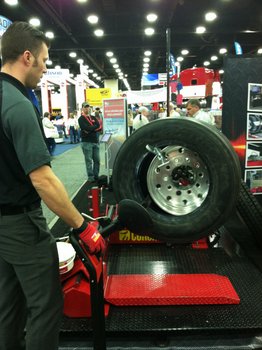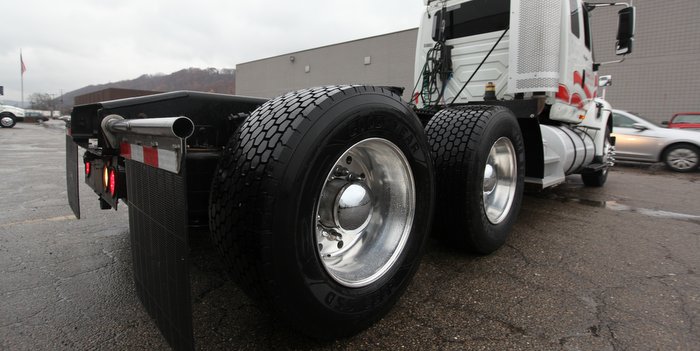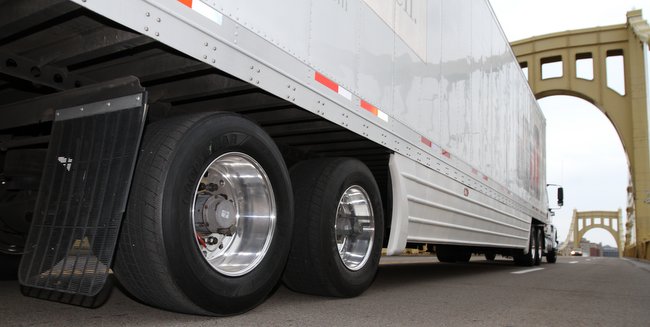Adoption of wide-base tires has increased since their entrance into the market in 2000. At first, fleets were hesitant to adopt these tires at first, primarily because there was initially a learning curve that needed to be addressed. Now that fleet operators know and understand the basic benefits of wide-base tires, the conversation has turned to more a more in-depth understanding of their benefits and limitations.
There are three basic reasons for a fleet operator to consider a vehicle with wide-base tires. The two most known advantages are weight, or mass, savings and fuel efficiency, while the unsung advantage comes in the form of load efficiency.
Weight savings for specific applications can be advantageous. Every pound that a bulk hauler, liquid tanker, waste hauler or linehauler saves makes the entire operation more profitable. According to Brian Buckham, marketing manager of the Goodyear Commercial Tire Systems business unit, wide-base tires with aluminum rims can reduce a truck’s GVWR by at least 1,100 lbs., which allows the truck to carry more payload.
 “Typically, we see about 740 lbs. of savings between a tractor and trailer between equivalent wheel types,” says Paul Crehan, director of product marketing at Michelin’s truck tires unit. “That’s a permanent savings through the life of the equipment.
“Typically, we see about 740 lbs. of savings between a tractor and trailer between equivalent wheel types,” says Paul Crehan, director of product marketing at Michelin’s truck tires unit. “That’s a permanent savings through the life of the equipment.
“Fleets carrying commodities that are heavy — bulk commodities — will have a higher concentration of wide-base tires,” Crehan continues. “The higher the mileage and the more weight sensitive you are, the more likely you are to fall into this option.”
“The fleets that realize the greatest potential from wide-base singles are those who ‘gross out before they cube out,’” notes Alex Chmiel, director of marketing at Continental’s commercial vehicle tires business group. “Conti has also seen some adoption in the construction segment such as cement mixers.”
Additionally, some fleets utilize the weight savings of wide-base tires to offset the actual weight of newer trucks on the market that must add weight to the vehicle to accommodate for new environmental and technical requirements.
“Included in that are the many applications like mining and logging where the trailers are metered,” Crehan adds. “So they know how many more logs they can put on before they hit the legal limits.”
Fuel savings is another reason for certain segments to turn to wide-base. Increased regulations such as those put forth by the California Air Resources Board (CARB) have been a main motivator for fleets to seek out more fuel-efficient tires, but so have rising fuel costs. Wide-base wheels generally offer an improved rolling resistance, according to Chmiel. “This is due to less sidewalls, less flexing, less energy loss and less weight than with a dual configuration.”
Chmiel notes that new technologies in tire production, including compounding, means that duals are rapidly catching up and sometimes surpassing wide-base tires in terms of fuel efficiency.
Buckham agrees, pointing out that with regulations from the EPA and new SmartWay-verified dual tires being put on the market, the return on investment for wide-base fuel savings is more difficult to quantify.
Michelin’s Crehan however, notes that if you’re doing an apples-to-apples comparison, typically you’ll see a 10% savings in rolling resistance when you do a complete conversion.
“In a truck that runs about 6 to 7 miles per gallon, you’re looking at 16,000 or so gallons per 100,000 miles. So you’re looking at $65,000 to 70,000 per 100,000 miles per truck.”
A lesser-known advantage is a single tire’s load efficiency. Wide-base wheels allow one tire to do the job of two.
“Long-term, that’s a very interesting proposition,” Crehan says. “Even if you had no other savings, the fact that you have 700 lbs. less material going in means that you have 700 lbs. less to recycle in the end.”
Less tires and material also equates to a simpler operation. One tire instead of two means fewer tires to inventory. It can also make casing management and purchasing easier. Servicing one tire instead of two is much easier and could reduce labor costs. Continental’s Chmiel also points out that Federal Excise Tax is lower on wide-base tires.
Preventative maintenance
is a must Tire manufacturers stress that fleets establish and keep up with proper preventative maintenance when choosing wide-base tires. Preventative maintenance practices, combined with new technology from tiremakers, negate some of the old concerns that come with purchasing wide-base tires.
“Wide-base tires required the fleet to evaluate whether their current maintenance program is designed to meet the operating characteristics of these tires,” Conti’s Chmiel says. “That may involve adoption of proactive maintenance like tire pressure monitoring systems.”
TPMS would catch a deflating tire miles before the tire erupted, leaving a truck on the side of the road. Roadside assistance is not as much of a problem as most of the major tire manufacturers offer fleets roadside assistance services across the country.
Tire manufacturers have also invested heavily in preventing tire damage by making wide-base tires more durable. Goodyear offers DuraSeal Technology, a preventative sealant that is built into the tire during the manufacturing process. DuraSeal seals nail-hole punctures of up to 1/4 in. in diameter in the repairable area of a tire’s tread.
“By sealing punctures, DuraSeal Technology helps protect the wide-base tire from air loss, which reduces the potential number of roadside breakdowns and helps ensure the casing integrity for additional retreads,” Buckham says.
Continental prevents punctures by incorporating a tread pattern that has anti-stone retention features in the tread grooves. The tiremaker also encourages fleets with wide-base tires to consider pulling the tire at 4/32nds and to measure tread depth in the shoulder, not just the centerline. This can prevent wear-related issues and many roadside failures.
On the note of casing, many tiremakers offer a retread program for their wide-base tires. Continental, Goodyear and Michelin all offer retread programs.
“In the past, it was more likely to only be able to have one retread on the casing,” Chmiel says. “With proper maintenance, fleet owners, today, can expect two retreads on the casing, if not more.”
Retread manufacturers have also begun offering wider tread widths, which provide a better fit to different manufactures’ casings. The wider widths ensure the cap meets the correct flex point on the tire’s footprint, which allows for better wear and a longer lifetime.
Conti recommends fleets that use wide base retreads make sure their retreaders offer shearography inspection as well as newer equipment, especially buffers.
“Many of the older buffers were not originally designed for wider casing widths and were retrofitted with the advent of retreading of wide singles,” Chmiel says. “Newer, computerized buffers make the buffing step more precise.”
Tiremakers have also ramped up roadside service resources. Michelin’s On Call service and Goodyear’s FleetHQ 24/7 Emergency Roadside Service program and network of Commercial Tire & Service Centers are two examples of tiremakers’ efforts to offer assistance to down trucks on the road. In addition to tiremakers resources, more and more service centers including truck stops and travels plazas carry wide base tires in the most common sizes.
Quicker adoption?
Wide-base tires are truly a segment-by-segment option—that is, they don’t offer everyone everything in terms of weight and cost savings. A fleet operator must invest time in making the switch and consider the pros and cons. With the emergence of low rolling resistance tires, SmartWay-approved duals and new technologies, duals may be the best option for your purposes. Understanding weight and fuel costs then working with the tiremaker to best optimize your fleet is a fleet operator’s best choice when considering the switch.
Ultimately, wide-base tires give fleet owners another tool to becoming more profitable given that they are operating fleets within specific applications. Duals are quickly becoming more competitive fuel savings-wise, making single-wides less desirable for a fleet. However, when spec’d and managed properly, wide-base tires can increase fuel efficiency and cut material costs, service time and increase the amount a tractor-trailer can haul.
“Aside from the fuel and weight benefits, the other performance differences between dual and wide-base tire can be smaller than the differences between two duals in the same category,” comments Michelin’s Crehan. “It’s really a matter of how best to optimize a fleet’s operations and that requires the fleet management, the drivers and the mechanics to be headed in the same direction.”















